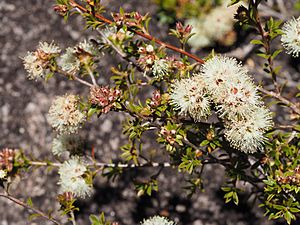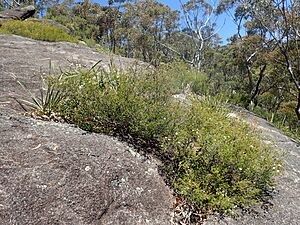Kunzea bracteolata facts for kids
Quick facts for kids Kunzea bracteolata |
|
|---|---|
 |
|
| Kunzea bracteolata leaves and flowers | |
| Scientific classification | |
| Genus: |
Kunzea
|
| Species: |
bracteolata
|
Kunzea bracteolata is a pretty plant from the myrtle family, called Myrtaceae. You can find it growing wild in parts of northern New South Wales and southern Queensland, Australia. It's a small shrub with branches that spread out. In late spring, it shows off lovely white flowers that smell like honey!
Contents
What the Kunzea Bracteolata Looks Like
This Kunzea bracteolata plant is a shrub that usually grows to about 1 meter (about 3 feet) tall. Its branches can spread up to 2 meters (about 6.5 feet) long. When the branches are young, they are a bit hairy.
Leaves and Flowers
The leaves of this plant are bright green and shaped like an oval. They are about 4 to 9 millimeters (about 0.15 to 0.35 inches) long and about 2 millimeters (about 0.08 inches) wide. Each leaf sits on a very short stalk, less than 1 millimeter long. When the leaves are young, they have fine hairs. You can usually only see the main vein in the middle of the leaf.
The flowers are white and have a strong, sweet smell, like honey! They grow in groups at the ends of the branches. Each flower has small, triangular parts called sepals, which are about 2 millimeters long. The petals, which are the soft, colorful parts of the flower, are about the same length. But the stamens, which are the parts that hold pollen, are about twice as long.
When it Flowers and Fruits
Kunzea bracteolata flowers from October to December. After the flowers bloom, they turn into small fruits. These fruits are about 3 millimeters (about 0.12 inches) long and wide.
How it Got its Name
Kunzea bracteolata was first officially described in 1905. Two scientists, Joseph Maiden and Ernst Betche, wrote about it in a science paper. The first plant sample used to describe the species was collected in 1904 by John Boorman. He collected many plants for the Sydney Botanic Gardens.
The second part of the plant's name, bracteolata, is a Latin word. It means "overlaid with scales," which describes a feature of the plant.
Where it Grows
This type of kunzea plant grows in forests where the soil is made of granite. You can find it in different spots north of Glen Innes in New South Wales. It also grows in southern Queensland. There's a large group of these plants in the Gibraltar Range National Park.
Using it in Gardens
Kunzea bracteolata is a great plant for gardens because it has so many beautiful, white flowers. These flowers have a lovely scent and attract many insects, like bees.
You can grow new plants from cuttings (small pieces of the plant). Once it's grown, this plant can handle cold weather (frost tolerant) and dry periods (drought tolerant). If you trim it regularly, it will keep a nice shape.


